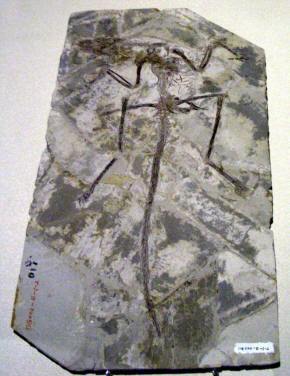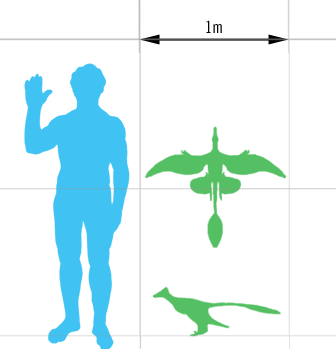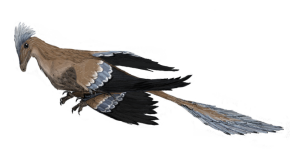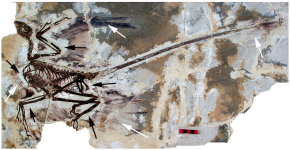|
Microraptor
was among the most abundant non-avialan dinosaurs in its ecosystem, and is
represented by more fossils than any other dromaeosaurid, with possibly over
300 fossil specimens represented across various museum collections.
Description
With adult specimens ranging 7790
centimetres long (2.533.0 ft) and with a weight estimated up to 1 kilogram
(2.2 lb), Microraptor
was among the smallest known dinosaurs.
Aside from its extremely small size,
Microraptor was among the first non-avian
dinosaurs discovered with the impressions of feathers and wings. Three
specimens of M. zhaoianus
have been described in detail, in addition to two specimens of
M. gui and three specimens
of M. sp. described
by Xu and colleagues in 2003, from which most feather impressions are known.
Unusual even among early birds and feathered dinosaurs,
Microraptor is one of the
few known bird precursors to sport long flight feathers on its feet as well
as its forearms and hands. Their bodies had a thick covering of feathers,
with a diamond-shaped fan on the end of the tail (possibly for added
stability during flight). Xu et al.
(2003) compared the longer plumes on Microraptor's head to those of the
Philippine Eagle. Bands
of dark and light present on some specimens may indicate color patterns
present in life. Several anatomical features found in
Microraptor, such as a
combination of unserrated and partially serrated teeth with constricted
'waists', and unusually long upper arm bones, are shared with both primitive
avians and primitive
troodontids.
Microraptor is
particularly similar to the basal troodontid
Sinovenator; in their 2002 description of
two M. zhaoianus
specimens, Hwang et al.
note that this is not particularly surprising, given that both
Microraptor and
Sinovenator are very
primitive members of two closely related groups, and both are close to the
deinonychosaurian split
between dromaeosaurids and troodontids.
Paleobiology
Wings and
flight
Microraptor
had four wings, one on both of
its forelegs and hind legs. The long feathers on the legs of
Microraptor were true
flight feathers as seen in modern birds, with
asymmetrical vanes on the arm, leg, and tail feathers. As in modern bird
wings,
Microraptor
had both primary (anchored to the hand) and secondary (anchored to the arm)
flight feathers. This standard wing pattern was mirrored on the hind legs,
with flight feathers anchored to
the upper foot bones as well as the upper and lower leg. It has been
proposed that the animal glided and probably lived mainly in trees, because
the hind wings anchored to the feet of
Microraptor would have hindered their ability to
run on the ground. It had long pennaceous feathers on
arms and hands (1020 centimetres long or 3.97.9 in), with legs and feet
1115 cm long (4.35.9 in). Toward the tail end,
Microraptor was covered in
shorter downy (plumulaceous) feathers, 26 cm long (0.792.4 in). Though not
apparent in most fossils under natural light, due to obstruction from
decayed soft tissue, the feather bases extended close to or in contact with
the bones, as in modern birds, providing strong anchor points.
When describing specimens originally
referred to the distinct genus Cryptovolans,
paleontologist Stephen Czerkas argued that
Microraptor may have been able to fly better
than
Archaeopteryx, noting
the fused sternum and asymmetrical feathers of
Microraptor, as well as features of the shoulder
girdle that indicate flying ability closer to modern birds than to
Archaeopteryx. Czerkas
cited the fact that this possibly
volant animal is also
very clearly a dromaeosaurid, to
suggest that the Dromaeosauridae might actually be a basal bird group, and
that later, larger, species such as
Deinonychus were secondarily flightless. The
work of Xu and colleagues also suggested that basal dromaeosaurs were
probably small, arboreal, and could at least glide, though later discoveries
of even more primitive dromaeosaurids with short forelimbs unsuitable for
gliding have cast doubt on this view.
Hind wing
posture
Sankar Chatterjee
determined in 2005 that, in order for
Microraptor to glide or fly, the fore and hind
wings must have been on different levels (as on a biplane)
and not overlaid (as on a
dragonfly), and that the latter posture
would have been anatomically impossible. Using this biplane model,
Chatterjee was able to calculate possible methods of gliding, and determined
that
Microraptor
most likely employed a
phugoid
style of gliding: launching itself from a perch, the animal would have
swooped downward in a deep U-shaped curve and then lifted again to land on
another tree. The feathers not directly employed in the biplane wing structure, like
those on the tibia and the tail,
could have been used to control drag and alter the flight path,
trajectory, etc. The orientation of the hind
wings would also have helped the animal control its gliding flight.
Chatterjee also used computer algorithms that test
animal flight capacity
to test whether or not
Microraptor
was capable of true, powered flight, in addition to passive gliding. The
resulting data showed that Microraptor
did have the requirements to sustain level powered flight, so it is
theoretically possible that the animal flew on occasion in addition to
gliding.
Some paleontologists have doubted
the biplane hypothesis, and have proposed alternate configurations. A 2010
study by Alexander et al.
described the construction of a lightweight three-dimensional physical model
used to perform glide tests. Using several different hind leg configurations
for the model, they found that the biplane model, while not unreasonable,
was structurally deficient and required a heavy-headed weight distribution
for stable gliding, which they deemed unlikely. The study indicated that a
laterally abducted hindwing structure represented the most biologically and
aerodynamically consistent configuration for
Microraptor. A further analysis by Brougham and
Brusatte, however, concluded that Alexander's model reconstruction was not
consistent with all of the available data on
Microraptor and argued that the study was
insufficient for determining a likely flight pattern for the dromaeosaur.
Brougham and Brusatte criticized the anatomy of the model used by Alexander
and his team, noting that the hip anatomy was not consistent with other
dromaeosaurs. In most dromaeosaurids, features of the hip bone prevent the
legs from splaying horizontally; instead, they are locked in a vertical
position below the body. Alexander's team used a specimen of
Microraptor which was
crushed flat to make their model, which Brougham and Brusatte argued did not
reflect its actual anatomy. Also in 2010, Alexander's team responded to
these criticisms, noting that the related dromaeosaur
Hesperonychus, which is known from complete
hip bones preserved in three dimensions, also shows hip sockets directed
partially upward, possibly allowing the legs to splay more than in other
dromaeosaurs.
Ground movement
Due to the extent of the hind wings
onto most of the animal's foot, many scientists have suggested that
Microraptor would have
been awkward during normal ground movement or running. The front wing
feathers would also have hindered Microraptor
when on the ground, due to the limited range of motion in the wrist and the
extreme length of the wing feathers. A 2010 study by Corwin Sullivan and
colleagues showed that, even with the wing folded as far as possible, the
feathers would still have dragged along the ground if the arms were held in
a neutral position, or extended forward as in a predatory strike. Only by
keeping the wings elevated, or the upper arm extended fully backward, could
Microraptor have
avoided damaging the wing feathers. Therefore, it may have been anatomically
impossible for Microraptor
to have used its clawed forelimbs in capturing prey or manipulating objects.
Some paleontologists have suggested
that feathered dinosaurs used their wings to parachute from trees, possibly
to attack or ambush prey on the ground, as a precursor to gliding or true
flight. In their 2007 study, Chatterjee and Templin tested this hypothesis
as well, and found that the combined wing surface of
Microraptor was too narrow
to successfully parachute to the ground without injury from any significant
height. However, the authors did leave open the possibility that
Microraptor could have
parachuted short distances, as between closely spaced tree branches.
Chatterjee and Templin also ruled
out the possibility of a ground-based takeoff.
Microraptor lacked the necessary adaptations in
its shoulder joint to lift its front wings high enough vertically to
generate lift from the ground, and the authors argued that a ground-based
takeoff would have damaged flight feathers on the feet. This leaves only the
possibility of launching from an elevated perch, and the authors noted that
even modern birds do not need to use excess power when launching from trees,
but use the downward-swooping technique they found in
Microraptor.
Implications
The unique wing arrangement found in
Microraptor raised
the question of its importance to the origin of flight in modern birdsdid
avian flight go through a four-winged stage, or were four-winged gliders
like Microraptor an
evolutionary side-branch that did not leave descendants? As early as 1915,
naturalist
William Beebe had argued that the evolution
of bird flight may have gone through a four-winged (or
tetrapteryx) stage.
Chatterjee and Templin did not take a strong stance on this possibility,
noting that both a conventional interpretation and a tetrapteryx stage are
equally possible. However, based on the presence of unusually long leg
feathers in various feathered dinosaurs,
Archaeopteryx, and some modern birds such as
raptors, as well as the discovery of further dinosaur with long primary
feathers on their feet (such as
Pedopenna), the authors argued that the
current body of evidence, both from morphology and phylogeny, suggests that
bird flight did shift at some point from shared limb dominance to front-limb
dominance, and that all modern birds may have evolved from four-winged
ancestors, or at least ancestors with unusually long leg feathers relative
to the modern configuration.
Feeding
In 2010 researchers announced that
further preparation of the type fossil of M.
zhaoianus revealed preserved probable gut
contents. These consisted of mammalian bones, including possible skull,
limb, and vertebral fragments and also a whole foot. The foot skeleton is
similar to those of
Eomaia and
Sinodelphys. It corresponds to an animal
with an estimated snout to vent length of 80mm and a mass of 20-25 grams.
The unguals of the foot are less curved than in
Eomaia
or
Sinodelphys,
indicating that the mammal could climb but less effectively than in the two
latter species.
------------Optional Reading Below This Line------------
Discovery
and species
Naming
controversy
The initial naming of
Microraptor was
controversial, because of the unusual circumstances of its first
description. The first specimen to be described was part of a chimeric
specimen a patchwork of unrelated feathered dinosaur species assembled
from multiple specimens in China and smuggled to the USA for sale. After the forgery
was revealed by
Xu Xing of
Beijing's
Institute of Vertebrate Paleontology and
Paleoanthropology,
Storrs L. Olson, curator of birds in the
National Museum of Natural History
of the
Smithsonian Institution,
published a description of the tail in an obscure journal, giving it the
name Archaeoraptor liaoningensis
in an attempt to remove the name from the paleornithological record by
assigning it to the part least likely to be a bird. However, Xu had
discovered the remainder of the specimen from which the tail had been taken
and published a description of it later that year, giving it the name
Microraptor zhaoianus.
Since the two names designate the
same individual as the type specimen,
Microraptor zhaoianus
would have been a
junior objective synonym
of Archaeoraptor liaoningensis
and the latter, if valid, would have had priority under the
International Code of Zoological Nomenclature.
However, there is some doubt whether Olson in fact succeeded in meeting all
the formal requirements for establishing a new taxon. Namely, Olson
designated the specimen as a
lectotype, before an actual type species was
formally erected. Most paleontologists have since ignored the name
Archaeoraptor, while the
name Microraptor zhaoianus
Xu et al., 2000 has
attained universal currency.
Other
species and specimens
A second specimen usually classified
as Microraptor was
first described (but not named) by Mark Norell and colleagues in 2002. In
addition to true wing feathers, this specimen appeared to have long feathers
similar to those on the wing stemming from the hind legs. Paleontologist
Stephen Czerkas also published an article on the same specimen a few months
later. Czerkas argued that the "hind leg feathers" were in fact simply the
long wing feathers overlapping the legs. Noting the long, aerodynamic
feathers of the wing and fused sternum characteristic of flying birds,
Czerkas proposed that this was the first recognized dromaeosaurid capable of
flight, naming it Cryptovolans pauli,
or "Paul's hidden flier", in honor of dinosaur researcher
Gregory S. Paul, who had long proposed that
dromaeosaurids evolved from flying ancestors. Czerkas noted several features
of the skeleton in this specimen (and a second, which he also classified as
Cryptovolans) which
he claimed separated it from Microraptor,
mainly proportions in the hand and tail. However, subsequent studies (and
more specimens of Microraptor)
have shown that these features are not unique, but are present to varying
degrees across various specimens. In a review by Phil Senter and colleagues
in 2004, the scientists suggested that all these features represented
individual variation across various age groups of a single
Microraptor species,
making the name Cryptovolans
a junior synonym of Microraptor.
Czerkas' interpretation of the hind
leg feathers noted by Norell proved to be incorrect the following year, when
additional specimens of Microraptor
were published by Xu and colleagues, showing a distinctive "hind wing"
completely separate from the forelimb wing. The first of these specimens was
discovered in 2001, and between 2001 and 2003 four more specimens were
bought from private collectors by Xu's museum, the
Institute of Vertebrate Paleontology and
Paleoanthropology. Xu also considered these
specimens, most of which had hind wings and proportional differences from
the original Microraptor
specimen, to be a new species, which he named
Microraptor gui. However, Senter also questioned
this classification, noting that as with
Cryptovolans, most of the differences appeared
to correspond with size, and likely age differences. Two further specimens,
classified as M. zhaoianus
in 2002 (M. gui had
not yet been named), have also been described by Hwang and colleagues.
Numerous further specimens likely
belonging to Microraptor
have been uncovered, all from the Shangheshou Bed of the
Jiufotang Formation in
Liaoning, China. In fact, Microraptor
is the most abundant non-avialan dinosaur fossil type found in this
formation. In 2010, it was reported that there were over 300 undescribed
specimens attributable to Microraptor
or its close relatives among the collections of several Chinese museums,
though many had been altered or composited by private fossil collectors.
In popular
culture
Microraptor
has appeared in a number of documentaries, books, and films. In 2008, it was
the subject of a
NOVA documentary,
titled The Four Winged Dinosaur.
The documentary focused on the controversy regarding the anatomy, flight
performance, and relationships of M. gui
using life-sized models built by artist Mick Ellison of the
American Museum of Natural History
and tested by paleontologists who have been involved with the study of the
original specimens, including Xu Xing and Larry Martin. The genus was
featured prominently in the third episode of the 2006 Impossible Pictures Limited
television series
Prehistoric Park,
which focused on the
Jehol Biota. In the episode, titled
"Dinobirds", Microraptor
were shown flocking down from trees to feast on the worms and insects
brought to the surface by the passage of giant
titanosaurs.
Return to the
Old Earth Ministries Online Dinosaur
Curriculum homepage.

Shopping
Bay
State Replicas - T-rex teeth, claws, skulls, jaws, foot, rib, femur,
complete skeleton (1/20 scale), brain cavity
Black
Hills Institute - Full size skulls, skeletons, 1/6th scale
disartictulated skull, teeth, arm, leg, femur, foot, claws.
Wall-mounted half-skull.
|



